
Lee Wiggins (Acting Operations Manager) reverses the engine preparing for the next leg of our journey.
The Zig Zag Railway is part of my life. My first memories of it are as a child: a treat for special occasions. When I became a parent, it was a feature in my children’s lives. We celebrated birthdays and whisked visitors out to ride the historic rails.

The author with her children in October 2007, awaiting their trip on Thomas the Tank Engine
And then it stopped.
The railway shut down in 2012 as the demands of a twenty-first century railway running with 1900s machinery took their toll. But volunteers and members of the Zig Zag Railway Co-operative did not give up. Instead, they set about restructuring, upskilling, and training to get it back on track.
From 2012 to 2023, each time it came close, disaster struck: bushfires in 2013, vandalism, a catastrophic bushfire in 2019/20 and then flood. But now, Acting CEO Dan Zolfel tells me they’ll be running regular services by winter. They are so close!
A members-only passenger run from Clarence to Bottom Points and back is the next step on their road to recovery. Dan invites me to record the train pulling out from the station.
I find myself at Clarence station readying for the long-awaited sight of a steam engine chuffing up the rails. Around me there are scores of families. An excited child marvels at the white stone ballast between the rails: “look how white the rocks are. Not black like before. It’s so cool. I have to stay calm!” Older generations remember past trips to Bottom Points and beyond. I chat to the parents of two volunteers, who tell me they first took the elder of their two sons here in the 1990s as a ten-year-old, his brother soon followed and “the rest is history.” They, like me, are holding their breath, huddled under umbrellas, their faces beaming with pride. Both of their sons are manning the engine today.
We hear the engine as it rounds the bend from Bottom Points. There is no sound like a steam train. You feel it in your body, as it thumps through sandstone bends cut over a hundred and fifty years ago.

Engine pulling into Clarence Station watched on by members eager to capture this historic moment.
The Zig Zag Railway first opened to traffic in 1869. It ran as a passenger train until it was superseded by a tunnel system in 1910. The first tourism operations ran in 1975, extending to Clarence in 1988. It is an extraordinary piece of engineering. The 21st Century Zig Zag team marvel at the complex skills of 19th Century railway men. Dan Zolfel tells me this is one of the things that attracts volunteers. As they work on engines and track, they often come across problems that just do not exist in a modern railway. “There are always problems to be solved. When you look at the ways they tackled these problems in the past, it is just inspiring. Back in the day, the guys were geniuses.”
This brings me to heart of the story: resilience, which Zig Zag has in coal shovels (‘spades’ just doesn’t capture it !) So, how does a team of volunteers keep coming back, despite so many adversities ?
Dan tells me that it has not been without challenges. There have been times when each of them has wondered aloud if it was too hard. But there is always someone in this close team to lift morale and remind the others what they have achieved and what could be possible .
Dan explains that people volunteer for different reasons: “There is something nostalgic about steam engines. It turns grown men into boys. There is five minutes of extreme joy when you pull into the platform and see the faces of kids light up. For me, I need to bring it back for my kids so they can feel it too.”
His own involvement was sparked watching the Garett Steam Engine 6029. He came across a fellow rail enthusiast there who told him Zig Zag would be back and they were looking for volunteers. He went straight home and applied. That was over six years ago. Two months ago, he stepped into the role of Acting CEO as part of the paid workforce of Zig Zag. The previous CEO (Lee Wiggins) who is now responsible for managing the rail operations, began as a volunteer as soon as he was old enough. Lee and Dan both proudly man the engine as it pulls into Clarence Station today.

L to R: Lee Wiggins, (Acting Operations Manager), Dan Rea ( Driver) and Dan Zolfel (Acting CEO and Fireman)
The challenges of operating a steam engine are constant. Dan tells me: “an engine is the closest thing to a living breathing animal you will ever come across. It eats coal, breathes air, drinks water, and is temperamental. You have to treat it right. In the hands of well-trained people who love it, it will run like clockwork. But some days, it’s just cranky!”
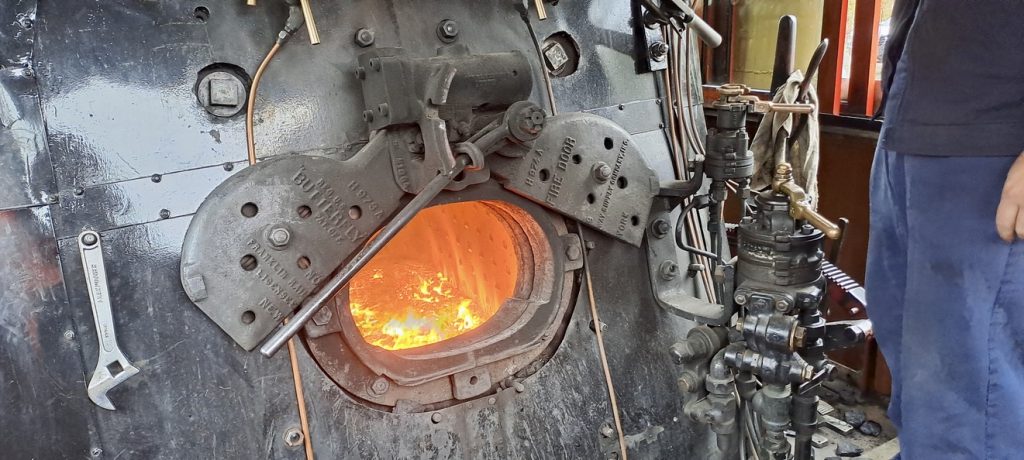
The firemen have fed their mechanical baby and are waiting for the signal men to give the all-clear!
But this railway is not just a few mates tinkering away in an engine shed. It is a professional railway required to meet the same rules and conditions as any other contemporary train. So how do they do it and just how many people does it take to change a burnt-out railway line into a thriving professional business?
Dan directs me to Geoff Moran, a fellow director of Zig Zag who has been a volunteer since the early 2000s. Dean of the Zig Zag Institute, Geoff is responsible for training volunteers. He tells me there are nine specific roles that must be filled each day for the railway to operate. This requires a larger pool of people trained in each role to ensure the railway can operate to a business timetable.

Geoff Moran, Dean of the Zig Zag Institute (Photo supplied)
Geoff explains that volunteers come from diverse backgrounds and there are many roles for them. It takes time and commitment to reach the standards required to be a driver, but not everyone wants to drive. Safety is paramount and everyone on the team must meet the Zig Zag’s Competency Standards before being authorised to work on the railway. Geoff and two other qualified assessors are responsible for signing off each volunteer before they progress through each stage of their training. But being certified for one thing doesn’t mean that’s your only job.
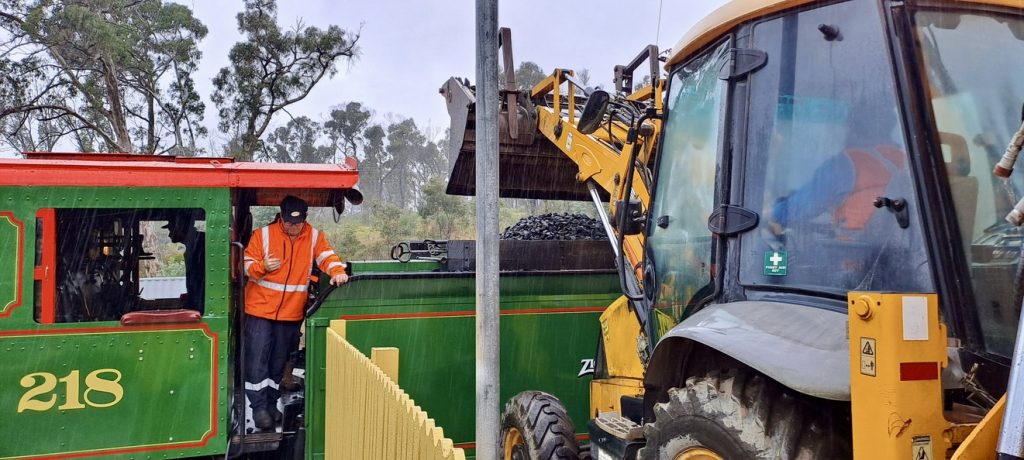
Acting CEO Dan Zolfel leaves the train to drive a font-end loader to feed the engine, guided in by Lee Wiggins. (My umbrella-holding husband marvels: “Is there anything he can’t drive?”)
I ask Geoff if I wanted to be a volunteer what would I have to do? The first step is to fill out the form on the website. I would then complete the online training through the Zig Zag Institute and induction program, obtain a Working with Children Check and pass a workplace medical, before being allowed on site.
The training ensures that all volunteers are aware of the systems, risks and expectations when operating a professional railway. If I completed this satisfactorily, I could start the hybrid training model, involving onsite practical training, which runs every second week. If the trainers considered I was ready, I would be assessed and certified for an entry-level position of signaller. With enough experience in this role, I could apply to begin training for certification in the next role.
How long does this all take? Geoff explains that there is no set timeframe, and it depends on a volunteer’s prior skills, experience, time and commitment. Geoff began his time at Zig Zag in 1989 when he was a primary school teacher. This was a drawcard for Dan Zolfel to join the Zig Zag volunteer team. He is a boilermaker by trade, but the railway is willing to take anyone and bring them through their accreditation system. The Zig Zag team are proud that many of the loco drivers and firemen of Australia’s most recognisable steam engine ‘3801’, spent time honing their skills at Zig Zag Railway.
I don’t see myself proceeding through the ranks to driver, so I jest that I am more suited to selling tickets! Geoff assures me this is an extremely important operating role, and encourages me to apply.
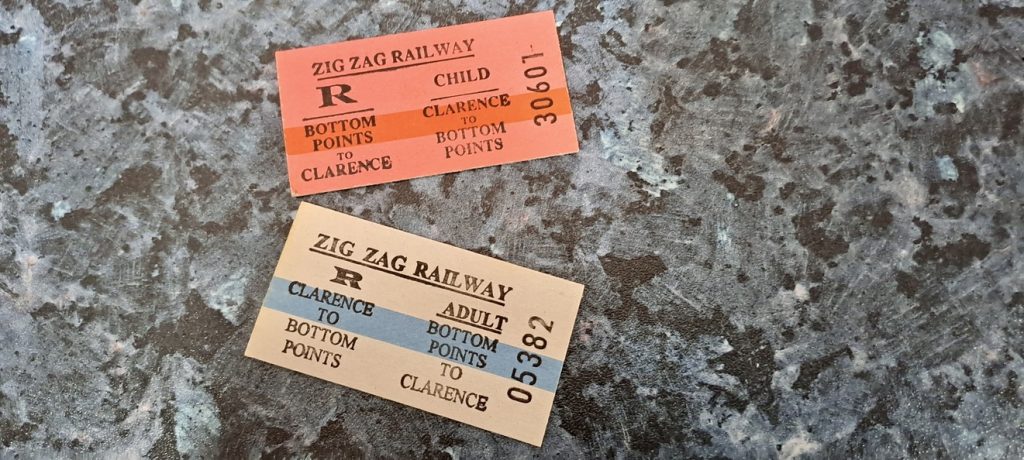
Yes, they even have real pre-numbered tickets!
It is clear that training and assessment are thorough and methodical. Geoff tells me that there is a core of around fifty volunteers at different stages of training and accreditation, but that number fluctuates as people have other commitments. If they can build the volunteer workforce to a hundred, they will be able to expand their service. Their plans for this are balanced against their ability to train and manage the workforce to ensure the railway operates safely and sustainably. Volunteers come from across the state, from young to young-at-heart, all united by a common love of trains. Around half their current volunteer team were with the railway prior to its closure in 2012 and many have joined since, inspired to help bring Zig Zag back to life.
Once Zig Zag is up and running to the public, they do not want to see it stop. For Geoff and Dan, the members day is the beginning of a new future for Zig Zag, no longer a headline of ‘coming soon’. Dan tells me that a year from now, “Zig Zag will be operating sustainably. We will have a regular weekend and school holiday schedule and we will be unveiling new experiences.”
I am surprised at his ambition, given the mountains they have had to climb to get this far, and I ask him about the long-term goals and challenges. He tells me: “We have hundreds of acres of crown land on the reserve. The railway is only just the start. We want visitors to keep coming back. Zig Zag should not be a tick-a-box exercise but an experience. There is an extensive network of bushwalking tracks and historical artefacts onsite. We aim to be the leader in heritage railway and sustainable tourism that others benchmark themselves against.”
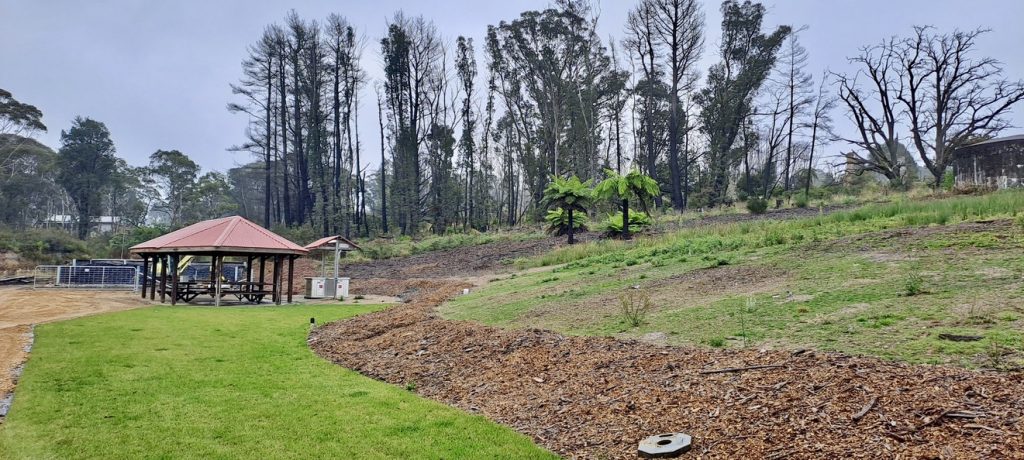
Part of the grounds regenerating in tandem with the Zig Zag Railway as it looks towards the future.
I am reminded of the Golden Book story of the little red engine as he puffs up the hill. “I think I can, I think I can.” And I ask Dan what will stop them. He replies “Well, assuming we don’t get burnt out or washed away or something else unprecedented, it is really volunteers, time, money and public perception. We need to be clear that we are back, and we are here to stay. My main focus as Acting CEO is sustainability. We do the job, we do it well and we do it week in, week out.”
He details all the factors that have resuscitated Zig Zag: volunteers, a strong team of professional staff, industry partners and funding of nearly $3 million through the NSW Department of Environment and Planning.
I ask Dan how many people they expect to visit the railway, and he tells me prior to closure in 2012 80,000 people visited Zig Zag each year. They are planning to meet and surpass that number as soon as operations allow. With that many people, I ask him about other facilities needed and he tells me about the container café they have leased to Tania Aussel (owner of the Tin-Shed café in Lithgow). With such a significant responsibility, the Zig Zag Cooperative is focused on railway operations and ensuring that other facilities on-site are also operated by those with appropriate expertise.
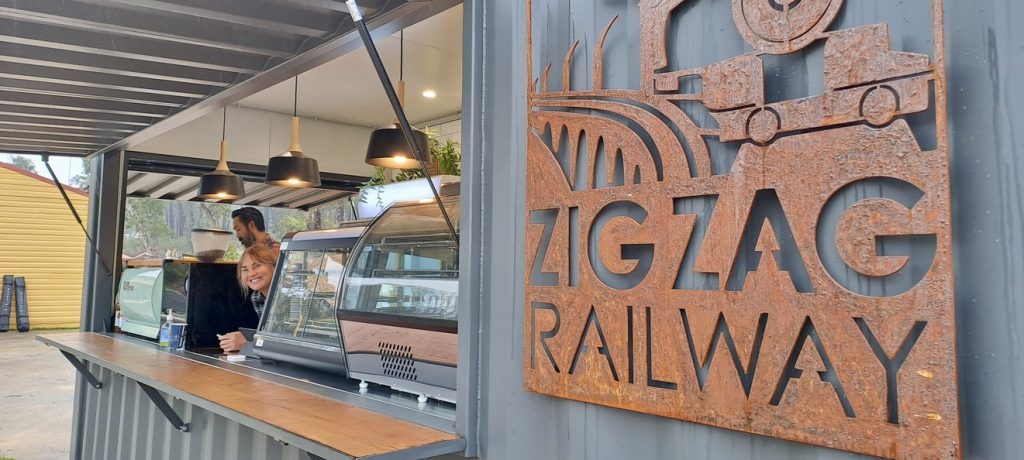
Tania Aussel at the Zig Zag Railway Cafe
Tania has set up ready for the members day, and tells me “I’m grateful to be a part of the re-emergence of Zig Zag, it was an opportunity too good to miss.” She promises fabulous Tin Shed coffees, and locally supplied food, ensuring the whole region benefits from the re-opening.
As I watch the members board the train, and the signaller flag for all clear, I am also grateful. I seriously need a coffee after all this excitement. The train is ready to pull out from the station and I wave to smiling members, gleefully aware of their good fortune, while members of the public, like me, huddle under our umbrellas and wait for the reopening.
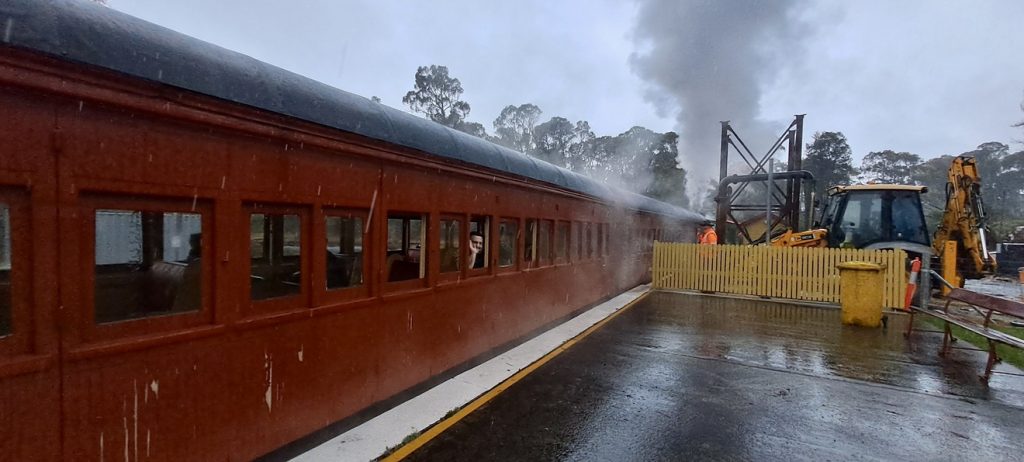
Waving member as the train leaves
In my mind, I hear the Golden Book engine loud and clear “I know I can, I know I can.” But in my ears, all I hear is this:
Sound file of engine pulling out. Credit: Ross Gurney, Sound engineer: Joss Arkley-Smith
It turned out I didn’t have to wait long. I was invited to the first trial of public passengers on the train on Sunday 14 May. What a treat! I had forgotten how beautiful the trip was through the zigs and zags. Pagodas, recovering bush, stunning heritage stone engineering and the generosity of the Zig Zag people, sharing their knowledge of this amazing feat of 19th Century engineering and 21st Century resilience.
You can book tickets online here.
The Zig Zag Railway Co-operative is always keen to hear from potential volunteers. If you are interested you can find the application form on the website.
A final tip for our readers: If you can, sit on the platform side of the train when you board at Clarence for an uninterrupted view.

The view as we pass over a viaduct on our way back to Clarence station.
This story has been produced as part of a Bioregional Collaboration for Planetary Health and is supported by the Disaster Risk Reduction Fund (DRRF). The DRRF is jointly funded by the Australian and New South Wales governments.




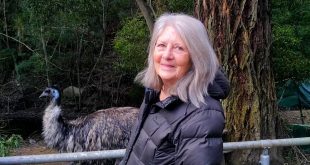
One comment
Pingback: Maldhan Ngurr Ngurra Lithgow Transformation Hub: An Evolving Story of Community & Learning – Lithgow Area Local News